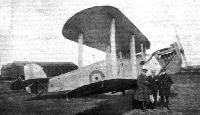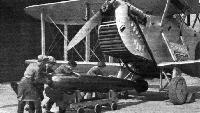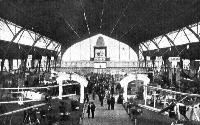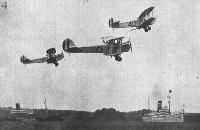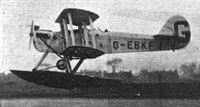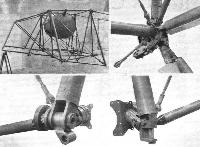
Описание
Страна : Великобритания
Год : 1920
Одноместный торпедоносец палубного и аэродромного базирования
Blackburn T.1 Swift и Т.2 Dart
В 1920 году фирма "Blackburn" в инициативном порядке построила прототип одноместного палубного торпедоносца, предназначенного для замены самолетов Sopwith Cuckoo. Blackburn T.1 Swift был оснащен W-образным двигателем Napier Lion IIB. По результатам испытаний прототип доработали с целью изменения положения центра тяжести, после чего испытания возобновились в мае 1921 года. Британских заказов на самолеты данного типа не поступило, но Министерство авиации заключило контракт на постройку трех модифицированных машин с крылом укороченного размаха. Первый из них - Т.2 Dart - выполнил первый полет в октябре. Испытания прошли успешно, после чего последовал заказ на постройку 26 самолетов Dart, первый из которых собрали в марте 1922 года.
В 1924 году Dart поступил на вооружение двух звеньев торпедоносцев, базировавшихся на авианосцах "Игл" и "Фьюриес". В 1929 году Dart впервые выполнил ночную посадку на авианосец "Фьюриес", находившийся в открытом море. Вслед за первым контрактом заказали постройку второй партии машин. Серийное производство завершилось в 1928 году, всего построили 117 экземпляров Dart. На машинах поздней сборки стояли моторы Lion V мощностью 465 л. с. В авиации британских ВМС на смену торпедоносцам Dart пришли самолеты Blackburn Ripon.
Три двухместных гражданских машины с поплавковым шасси закупила кампания "North Sea Aerial and General Transport Co.Ltd", которая использовала их по контракту с Министерством авиации для подготовки пилотов резерва британских ВВС.
На экспортных вариантах самолета Dart, получивших наименование Swift, стояли моторы Lion мощностью 450 л. с. Первые два из семи экспортных самолетов были поставлены ВМС США под обозначением Swift F. Оценочные испытания показали, что Swift F не подходит для американцев из-за отсутствия второго члена экипажа (штурмана), после чего американский флот заказал самолеты Douglas DT-2. Другими покупателями стали ВМС Японии (два самолета) и ВМС Испании (три).
ТАКТИКО-ТЕХНИЧЕСКИЕ ХАРАКТЕРИСТИКИ
Blackburn Т.2 Dart
Тип: одноместный торпедоносец палубного и аэродромного базирования
Силовая установка: W-образный мотор Napier Lion 116 мощностью 450 л. с.
Характеристики: максимальная скорость на высоте 305 м 172 км/ч; крейсерская скорость на высоте 1525 м 167 км/ч; скороподъемность 183 м/мин; практический потолок 3870 м; продолжительность полета 3 ч
Масса: пустого 1632 кг; максимальная взлетная 2895 кг
Размеры: размах крыла 13,86 м; длина 10,78 м; высота 3,94 м; площадь крыльев 60,76 м
Вооружение: торпеда Mk VIII или Mk IX, или до 472 кг бомб на внешней подвеске под фюзеляжем
Описание:
- Blackburn T.1 Swift и Т.2 Dart
- Flight, July 1920
The Olympia Aero Show 1920 - Flight, July 1923
Gothenburg International Aero Exhibition 1923 - Flight, May 1925
THE BLACKBURN TWIN-FLOAT SEAPLANE
Фотографии
-
Flight 1920-07 / Flight
AT OLYMPIA: The Blackburn "Swift" is a torpedo-carrying machine designed for starting from and alighting on the platform of a ship
-
Air Enthusiast 1996-05 / H.Woodman - Blackburn Dart. The Fleet Air Arm's Seminal Torpedo Bomber
Регистрационный номер: N139 The prototype Swift Mk I at Martlesham in January 1921. One of the various rudder/fin arrangements is seen here and the nose displayed in all its original ugliness. The wings have been swept back after Kenworthy’s hair-raising first test flight.
-
Flight 1921-11 / Flight
The Blackburn "Swift" torpedo 'plane, fitted with a 450 h.p. Napier "Lion."
-
Flight 1939-05 / Flight
The Dart was used in the Fleet Air Arm for many years as a single-seater torpedo carrier. Training versions were two-seaters.
-
Aeroplane Monthly 1988-05 / Personal album. Military
Регистрационный номер: N9561 Blackburn Dart N9561; this unlovely torpedobomber type served with the FAA from 1923-33.
-
Jane's All the World Aircraft 1980 / Encyclopedia of Aviation - Aircraft A-Z - v2
Регистрационный номер: N9542 [2] Blackburn Dart.
-
Flight 1924-05 / Flight
The Blackburn "Swift" torpedo plane single-seater, Napier "Lion" engine. Can also be supplied as a two-seater Bomber.
-
Aeroplane Monthly 1986-03 / Personal album
Регистрационный номер: N9539 Blackburn Dart N9539 was part of a batch of 26 Darts requisitioned in 1922. These single-seat carrier-borne torpedo bombers were powered by the 450 h.p. Napier Lion IIB, or the 465 h.p. Lion V engine.
-
Air Enthusiast 1996-05 / H.Woodman - Blackburn Dart. The Fleet Air Arm's Seminal Torpedo Bomber
One of the export Swifts, one of the three built for the Spanish Navy, being paraded here at Brough in 1923 for a publicity photograph. The appearance of the undercarriage under full load should be noted also the need for a generous tail skid.
-
Air Enthusiast 1996-05 / H.Woodman - Blackburn Dart. The Fleet Air Arm's Seminal Torpedo Bomber
Регистрационный номер: N9542 [2] Rear view of N9542, the seventh production Dart. The original cockpit was circular but was subsequently enlarged by being cut back at the rear. The upper centre section slinging gear and the torpedo sighting bar can be seen
-
Flight 1923-04 / Flight
The Blackburn "Swift" Torpedoplane.
-
Air Enthusiast 1996-05 / H.Woodman - Blackburn Dart. The Fleet Air Arm's Seminal Torpedo Bomber
Close-up of the lower extremities of the Swift export model displays the substantial divided undercarriage, the torpedo crutches and pistol stop. A hand starting crank handle can be seen at upper right
-
Aeroplane Monthly 1978-09 / Personal album
Plt Off Monk poses in front of a Dart at Gosport in 1926.
-
Flight 1924-05 / Flight
Loading a torpedo on the Blackburn "Swift" torpedo 'plane, Napier "Lion" engine.
-
Air Enthusiast 1996-05 / H.Woodman - Blackburn Dart. The Fleet Air Arm's Seminal Torpedo Bomber
Регистрационный номер: N9806 В мае 1921 года собран первый прототип самолета Blackburn Dart, родоначальник большого семейства самолетов для авиации ВМС.
Immaculate Dart N9806 in front of a hangar at Brough. The aeroplane was presumably photographed after renovation as it has Handley Page slots fitted but still has the old deck landing hooks clamped to the stub axles. Tubular bomb carriers are fitted under the wings -
Flight 1923-08 / Flight
BRITAIN AT I.L.U.G.: This set of photographs, kindly supplied by the S.B.A.C., shows some of the British exhibits at the Gothenburg International Aero Exhibition, which has just closed. The Blackburn Torpedoplane, with Napier "Lion."
-
Flight 1922-06 / Flight
THE R.A.F. AERIAL PAGEANT: Interesting machine which will make its first public appearance at the Pageant: The Blackburn "Dart" torpedo-carrier, with Napier "Lion"; specially designed for alighting on a ship.
-
Мировая Авиация 57
Предкрылок типа Handley-Page устанавливался на самолеты Т.2 с 1928 года. Английские моряки вручную откатывают Dart на палубе авианосца, снимок 1932 года.
-
Air Enthusiast 1996-05 / H.Woodman - Blackburn Dart. The Fleet Air Arm's Seminal Torpedo Bomber
Регистрационный номер: N9804 F/L G Boyce of 462 Flight lands Dart N9804 on the deck of HMS Furious on May 6, 1926, the first nocturnal carrier deck landing. The Dart displays the red sash of Furious and the Fleet number ‘74’.
-
Aeroplane Monthly 1976-12 / Personal album
A view of a congested aft deck, with Blackburn Darts, Fairey IIIFs and, in the foreground, a Blackburn Blackburn Mk I in evidence. The unsightly Blackburn was designed for reconnaissance and gunnery fire control, and proved very successful in this role. The engine was a 450 h.p. Napier Lion IIB.
Другие самолёты на фотографии: Blackburn Blackburn / R.1 - Великобритания - 1922Fairey Fairey IIIF - Великобритания - 1926
-
Flight 1928-05 / Flight
SOME BLACKBURN AEROPLANES "ON PARADE": Left to right, a "Cirrus-Bluebird," a "Genet-Bluebird," a "Lynx-Lincock," a "Napier" Ripon, and a "Napier-Dart."
Другие самолёты на фотографии: Blackburn Bluebird / L.1 - Великобритания - 1924Blackburn Lincock / F.2 - Великобритания - 1928Blackburn Ripon / T.5 - Великобритания - 1926
-
Flight 1924-06 / Flight
GENERAL VIEW FROM THE THIRD INTERNATIONAL AERO EXHIBITION AT PRAGUE: The photograph shows the British stand, with the "Avro-Lynx" on the left and the Blackburn "Dart" on the right.
Другие самолёты на фотографии: Avro Avro 504N - Великобритания - 1920
-
Aeroplane Monthly 1974-09 / ??? - Hendon Pageantry 1920-37
A general view of the participators at the 1922 pageant. Note the Parnall Puffin floatplane and Blackburn Darts on the left. Also present was the large Avro Aldershot.
Другие самолёты на фотографии: Avro Aldershot / Type 549 - Великобритания - 1922Parnall Puffin - Великобритания - 1920
-
Flight 1932-06 / Flight
Регистрационный номер: N9694 -
Flight 1924-07 / Flight
THE R.A.F. PAGEANT: THE Event of the Day. British aircraft appearing on the scene are fired at with the "Slevic's" anti-aircraft guns, which are silenced by a formation of Fairey "Flycatcher" fighters until (on photo) a formation of Blackburn "Dart" torpedo-carriers discharge their torpedoes.
-
Flight 1926-07 / Flight
"SET PIECES" AT THE R.A.F. DISPLAYS: At each of the previous "Pageants" and Display a grand finale was given in which some episode relating to aerial warfare was realistically enacted, viz. :- (4) 1924, the Raider raided. The enemy merchant cruiser "Selvic" is caught in the act of holding up the "John Henry," of Newcastle, and is eventually sent to Davy Jones by a flight of Blackburne "Dart" torpedo 'planes.
-
Aeroplane Monthly 1974-09 / ??? - Hendon Pageantry 1920-37
The grand finale in 1924 was a set piece involving two replica ships. Here we see a trio of Blackburn Darts that have just released their torpedoes at the foe.
-
Air Enthusiast 1996-05 / H.Woodman - Blackburn Dart. The Fleet Air Arm's Seminal Torpedo Bomber
Регистрационный номер: N9997 N9997 equipped with a stannic acid smoke-making canister off Leuchars.
-
Aeroplane Monthly 1986-03 / Personal album
Регистрационный номер: N9990 Blackburn Dart N9990 was from a batch of 10 Darts ordered in January 1925. The type became the Fleet Air Arm’s standard torpedo bomber until replaced by the Blackburn Ripon in 1931. Both types were carrier-borne and could be operated on wheeled or float undercarriages.
-
Aeroplane Monthly 1978-09 / Personal album
Регистрационный номер: N9717 Plt Off Monk, piloting Blackburn T.2 Dart torpedo bomber N9717, makes an experimental torpedo drop at Gosport on August 22, 1927. Virtually a re-rigged, reduced-span version of its predecessor, the Swift, the Dart was powered by the Napier Lion of 450-465 h.p.
-
Aeroplane Monthly 1978-09 / Personal album
Регистрационный номер: N9552 [4] Pg Off Monk (promoted!) releases a dummy 15ft torpedo from Dart N9552 at Gosport in October 1927. Although the Dart had no guns, the torpedo, which weighed about 1,500lb, could be replaced by an underwing bomb load, the largest load in this form being a pair of 520-pounders. The bomb racks can be seen in this photograph.
-
Aeroplane Monthly 1982-02 / Personal album
Регистрационный номер: N9543 The Blackburn Dart single-seat carrier-borne torpedo-carrier entered service in 1923 and remained with the FAA until 1933. Dart N9543, seen dropping an 18in torpedo, was delivered from the Blackburn factory in November 1922.
-
Air Enthusiast 1996-05 / H.Woodman - Blackburn Dart. The Fleet Air Arm's Seminal Torpedo Bomber
Регистрационный номер: N9690 Dart N9690 of the Torpedo Training Flight at Gosport circa 1926 drops its 'mouldie' (naval slang for torpedo) at a rather low level. The item at the rear of the torpedo is a drogue and when it entered the water a cable unwound and the drogue was dragged behind prevented the torpedo plunging too deeply and eventually slowing its passage to aid recovery.
-
Aeroplane Monthly 1978-09 / Personal album
Регистрационный номер: N9797 A 15ft torpedo drops away from Plt Off Monks' Dart, N9797, off Gosport in 1926. The Isle of Wight is visible on the horizon to the left. Despite its large size for a single-seater, the Dart was a pleasant aeroplane to fly, and its 38kt landing speed made carrier landings easy.
-
Aeroplane Monthly 1978-09 / Personal album
Регистрационный номер: N9689 Plt off Monk drops a dummy 15ft torpedo into the Solent off Gosport on September 27, 1926. This time his mount is Dart N9689, which was reconditioned in 1924 and redelivered from the company's Brough airfield to Farnborough, en route to Gosport, on October 31 that year.
-
Aeroplane Monthly 1978-09 / Personal album
Регистрационный номер: N9552 [4] Left: N9552 again, this time dropping a dummy 12ft torpedo off Gosport in November 1927. The caption states that Fg Off Monk was with 465 Flight at this time. Dart N9552 was flown to Gosport via Northolt on February 22, 1923, piloted by Fg Off Harrison, so it obviously enjoyed a long and active life.
Right: Our old friend N9552 again, with Monk in charge. As noted previously, the fuselage markings suggest that this picture was taken about 1928. A notable addition is the complex aerial array stretched between the rudder and wing trailing edges, just inboard of the ailerons. -
Air-Britain Aeromilitaria 1980-03
A Blackburn Dart drops its torpedo
-
Air Enthusiast 1996-05 / H.Woodman - Blackburn Dart. The Fleet Air Arm's Seminal Torpedo Bomber
Unidentified Dart with wing pennants (actually socks) indicating torpedo flight (blue and yellow).
-
Air-Britain Aeromilitaria 1982-03
Blackburn Dart
-
Flight 1924-05 / Flight
SALUTING THE DOMINION PREMIERS AT CROYDON: The Blackburn "Dart" flying above the Blackburn "Blackburn" fleet spotter. Both are fitted with Napier "Lion" engines.
Другие самолёты на фотографии: Blackburn Blackburn / R.1 - Великобритания - 1922
-
Air-Britain Aeromilitaria 1978-02
HMS Glorious and one of her Blackburn Dart torpedo-bombers
Our photographer has caught a Blackburn Dart as well as the Glorious at anchor. The Dart torpedo-bombing aircraft is still used in some carriers, but it is being replaced by Blackburn Ripons. -
Air-Britain Aeromilitaria 1978-02
Регистрационный номер: N9552 [4] F/O R C H Monk lands Dart N9552 on the deck of Courageous cruising off the Isle of Wight in 1928. Note that at this stage there were no arrester wires fitted to the deck. The Dart is from 463 Flight and sports the light blue sash of Courageous and the white Fleet number ‘74’.
-
Aeroplane Monthly 1978-09 / Personal album
Регистрационный номер: N9552 [4] Fg Off Monk touches down on HMS Courageous, off the Isle of Wight, in 1928. This Dart may well be N9552 again. Note the deckhands preparing to meet the aircraft. At this period no arrester system other than manpower was in use by the FAA. The Dart's jury struts for wing folding are already in position at the wing roots.
-
Air Enthusiast 1996-05 / H.Woodman - Blackburn Dart. The Fleet Air Arm's Seminal Torpedo Bomber
Регистрационный номер: G-EBKF [9] A New Blackburn: Three-quarter front view of the school seaplane, fitted with Napier "Lion" engine, which was flown very successfully recently.
Dart seaplane G-EBKF at Brough in 1925. The white undercoat discs seen on the wings where the RAF roundel would have been painted supports the theory that G-EBKF and her two sisters were diverted from an Air Ministry contract and acquired by Blackburn. Note the patent beaching wheels and beautifully made mahogany floats. -
Flight 1925-01 / Flight
Регистрационный номер: G-EBKF [9] Side view of the Blackburn school seaplane. Note the back-swept wings.
-
Flight 1925-05 / Flight
Регистрационный номер: G-EBKF [9] The Blackburn "Dart" Seaplane: The machine just leaving the slipway, the wheels not yet having been raised.
-
Aeroplane Monthly 1982-05 / G.Todd - Rover's Return
Регистрационный номер: G-EBKF [9] TWO BLACKBURN SCHOOL MACHINES: On the left, the "Dart" seaplane, with Napier "Lion" engine; and on the right, the "Bluebird" light 'plane, with Blackburne engine.
The two-seat Blackburn Dart seaplane G-EBKF, and the prototype Blackburn Bluebird, G-EBKD at Brough early in 1925.Другие самолёты на фотографии: Blackburn Bluebird / L.1 - Великобритания - 1924
-
Flight 1927-03 / Flight
Blackburn "Dart" (Napier "Lion"). This torpedo 'plane, designed for deck landing, is more or less a modification of the early "Swift," and has been constructed as a single-seater and two-seater. It is of steel structure, with the exception of the wings, with main joints of the spool type. The sharp downward sweep of the top of the fuselage to the engine cowling allows a very clear view. When it was originally designed many foreign countries purchased a few for experimental purposes, and it was made under licence in France by a well-known French firm. It is used by Flights No. 461 (H.M.S. Furious); No. 462 (H.M.S. Furious); and No. 460 (H.M.S. Eagle).
-
Air Enthusiast 1996-05 / H.Woodman - Blackburn Dart. The Fleet Air Arm's Seminal Torpedo Bomber
Регистрационный номер: G-EBKF [9] Although this is the Dart seaplane G-EBKF, the contours of the nose are admirably revealed here which gave the Dart its pugnacious appearance. Note the extended exhausts intended to keep the torpedo warm during flight
-
Flight 1925-05 / Flight
Регистрационный номер: G-EBKF [9] The Blackburn "Dart" Seaplane: Front view of the machine at the top of the slipway.
-
Flight 1939-05 / Flight
Регистрационный номер: G-EBKF [9] The Dart torpedo carrier was adapted as a seaplane trainer for Reserve use.
-
Flight 1925-04 / Flight
Регистрационный номер: G-EBKF [9] SCHOOL WORK AT BROUGH: These photographs, secured on a recent visit to the North Sea Aerial and General Transport Company's station show the Blackburn "Dart" seaplane, fitted with Napier "Lion" engine, which is used for seaplane training. It should be noted that a though the machine is not an amphibian in the usual sense of the term, the landing-wheels are carried on board, but are raised clear once the machine has taken the sea. They are lowered for transport on land and in launching and coming in. The upper left-hand photograph shows the "Dart" taking off, piloted by Mr Woodhouse and in the lower right-hand picture it is seen alighting. The other photographs are self-explanatory.
-
Flight 1925-05 / Flight
Регистрационный номер: G-EBKF [9] THE BLACKBURN "DART" SEAPLANE: The tail, with balanced rudder and elevator.
-
Flight 1925-05 / Flight
THE BLACKBURN "DART" SEAPLANE: The sprung skid on the heel of a float.
-
Flight 1925-05 / Flight
THE BLACKBURN "DART" SEAPLANE: The trolley, and its framework. This trolley is raised clear of the water as soon as the machine is afloat.
-
Flight 1925-05 / Flight
THE BLACKBURN "DART" SEAPLANE: Three views of the engine housing, engine mounting, and complete nose. The engine is a Napier "Lion."
-
Flight 1925-05 / Flight
THE BLACKBURN "DART" SEAPLANE: Some constructional features. In the upper left-hand corner is a view of the steel tube centre portion of the fuselage. Note the system of triangulation, and the main petrol tank. The other photographs show typical fittings, machined from the solid.
-
Flight 1925-05 / Flight
THE BLACKBURN "DART" SEAPLANE: A view into the cockpit, showing control wheel instrument-board, starting magneto, etc.
-
Air Enthusiast 1996-05 / H.Woodman - Blackburn Dart. The Fleet Air Arm's Seminal Torpedo Bomber
An unfortunate Dart from 461 Flight (Furious) upside down in the ‘drink’. The original caption stated that the dummy torpedo fouled the propeller when dropped, possibly caused by the pilot assuming too steep an angle immediately prior to the release.
-
Aeroplane Monthly 1976-12 / Personal album
Регистрационный номер: N9817 The caption "picking up Boozy’s ship", tells us that the unfortunate pilot of Blackburn Dart torpedo-bomber N9817 was none other than Lt Byas, later to become CO of 803 Squadron aboard HMS Hermes and affectionately known by all as "Boozy Byas". N9817 is recorded as having sunk in the Mediterranean in 1931 - presumably the incident depicted.
-
Air-Britain Aeromilitaria 1984-04
Регистрационный номер: N9820 Dart N9820 argues with a shed while disembarked
-
Aeroplane Monthly 1990-04 / Personal album. Civil
Регистрационный номер: G-EBKH Blackburn T.2 Dart G-EBKH was built as a seaplane in 1926 at the Olympia works in Leeds. It was first registered to NSA> and flown at Brough, being converted to a landplane in 1929. After its C of A expired in May 1933 the Dart became a local landmark outside the garage of Reg Fowler in Doncaster Road, Hatfield, Yorkshire, remaining there until 1952 when its bare skeleton was finally scrapped.
-
Air Enthusiast 1996-05 / H.Woodman - Blackburn Dart. The Fleet Air Arm's Seminal Torpedo Bomber
The heart of the Dart, the tubular steel middle section with main tank and the detachable front section which enabled easy engine removal and replacement.
-
Flight 1920-07 / Flight
SOME DETAILS OF THE BLACKBURN "SWIFT": On the left the interplane strut attachment In the centre the undercarriage, and on the right the tail skid
-
Air Enthusiast 1996-05 / H.Woodman - Blackburn Dart. The Fleet Air Arm's Seminal Torpedo Bomber
General arrangement of the depth control adjustment gear which had been developed for the single-seat Swift and Dart, it did not change over the years.
-
Мировая Авиация 57
Blackburn Dart
-
Flight 1925-05 / Flight
Blackburn "Dart" Seaplane Napier "Lion" Engine
-
Air Enthusiast 1996-05 / H.Woodman - Blackburn Dart. The Fleet Air Arm's Seminal Torpedo Bomber
The main side and front views show the Dart on the ground (without full load) and with Handley Page slots, radio and night flying gear. The later cut-back cockpit is depicted and the skeletal side view shows a Mk VIII torpedo fitted with drogue.
- Фотографии






